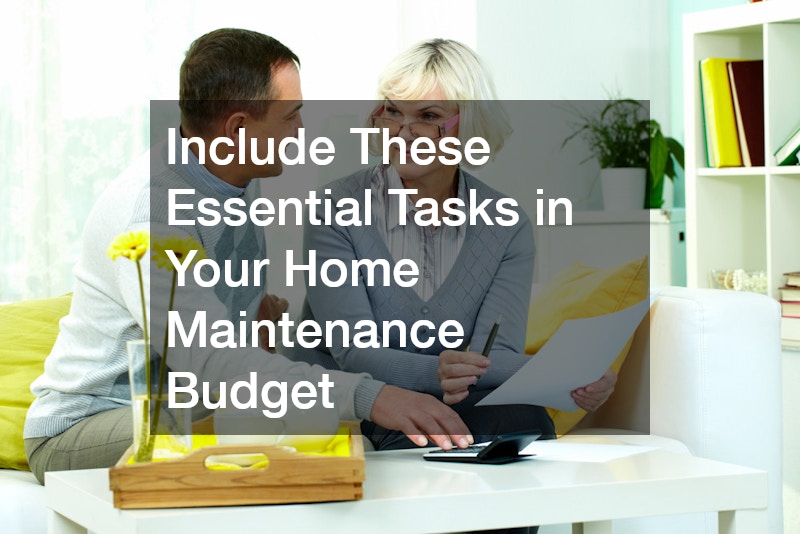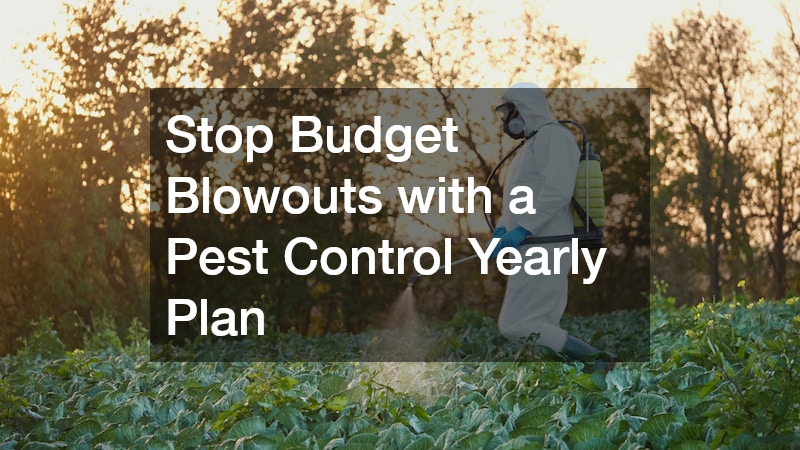Include These Essential Tasks in Your Home Maintenance Budget
Maintaining a home is a significant responsibility, and budgeting for it is crucial. A well-thought-out home maintenance budget helps ensure that necessary repairs are completed and can also increase your property’s value. This guide will help Australian homeowners create a comprehensive budget, covering everything from seasonal tasks to preventive maintenance.
- How Often Should Your Home Maintenance Budget Be Reviewed?
Regularly reviewing your home maintenance budget is essential for staying on top of costs. At a minimum, assess your budget annually, but reviewing it quarterly can provide valuable insights into spending patterns and future needs. Australia’s distinct seasonal variations, such as summer heatwaves and winter chills, impact maintenance priorities, so adjust your budget accordingly.
During these reviews, consider creating a checklist of potential services. For example, plan for gutter cleaning before autumn rains or schedule an air conditioning service before summer. Proactively managing these tasks will help you avoid unexpected expenses and improve budget efficiency.
When reviewing your budget, account for factors such as your home’s age, condition, and your lifestyle. For instance, older homes may require more frequent plumbing or cabinetry inspections. A flexible and organised budget allows homeowners to prioritise tasks, track expenses, and adjust as needed.
- Common Home Maintenance Tasks to Include in Your Budget

Home maintenance involves a wide range of tasks, from essential system upkeep to aesthetic improvements. Key tasks include regular inspections and repairs of major systems, such as heating, ventilation, and air conditioning (HVAC) units. Plumbing maintenance, like periodic drain cleaning or checking for leaks, is also essential.
Outdoor maintenance is another critical area. In summer, many Australian homeowners work with fencing contractors to address wear and tear or hire professionals to repair decks damaged by harsh sun and weather. Addressing these needs promptly can save on long-term costs and extend the life of outdoor structures.
Smaller yet important tasks, such as garage door servicing, gutter cleaning, and maintaining garden areas, should also be scheduled. By cataloguing these tasks and allocating funds, homeowners can minimise stress and maintain the functionality and appearance of their homes.
- Estimating the Cost of Home Maintenance
Accurate cost estimation is vital for a successful maintenance budget. Begin by researching the average costs of services in your area. Contact local tradespeople, such as HVAC technicians, plumbers, or fencing contractors, for quotes. Use these figures as a baseline for recurring services like air conditioning maintenance or drain cleaning.
Using budgeting tools or spreadsheets can help you track expenses and make adjustments over time. By incorporating inflation and potential cost increases for materials, your budget will better reflect actual expenses. For instance, compare quotes from multiple contractors for fencing repairs to secure competitive pricing.
Taking the time to estimate costs not only aids in effective budgeting but also helps avoid surprises. A detailed and realistic budget supports long-term savings and better home maintenance planning.
- Seasonal Impacts on Your Home Maintenance Budget
Seasonal changes in Australia significantly influence home maintenance priorities. Each season comes with specific tasks to address. For instance, winter might require a focus on heating system checks and insulation, while summer calls for air conditioning maintenance and outdoor repairs.
Autumn’s falling leaves can clog gutters, necessitating regular cleaning to prevent water damage. In spring, homeowners often engage professionals to inspect decks or fences for issues caused by winter weather. Having a flexible budget that accommodates these seasonal adjustments ensures you’re prepared for the year-round demands of home maintenance.
Proactive seasonal preparation not only preserves your home’s structural integrity but can also lead to energy and cost savings. By anticipating seasonal needs, you’ll reduce the likelihood of unexpected breakdowns or emergencies.
- The Importance of Preventive Measures in Your Annual Budget
Preventive maintenance is a cost-effective strategy that minimises the risk of significant repairs down the line. Regular inspections, such as checking plumbing systems or HVAC units, help identify small issues before they escalate. Including preventive measures like gutter cleaning or cabinet inspections in your budget will save money over time.
Aesthetic and functional aspects of your home also benefit from preventive care. For example, inspecting kitchen cabinetry for wear can help you address problems early, avoiding costly replacements. Similarly, high-quality materials and timely repairs contribute to long-term durability.
By investing in preventive measures, you ensure your home remains in good condition, reducing the likelihood of major disruptions and keeping your maintenance budget under control.
- Prioritising Maintenance Tasks on a Limited Budget
When funds are limited, prioritising maintenance tasks becomes essential. Start by identifying the most urgent issues, focusing on safety and those with the potential to cause further damage. For instance, repairing a malfunctioning garage door should take precedence over non-urgent landscaping projects.
Consider the consequences of delaying certain tasks. Ignoring a faulty heater could lead to higher energy bills or a complete breakdown during winter. Addressing high-priority issues first ensures a safe and functional living environment.
Bundling similar tasks can also help save on costs. For example, schedule plumbing and HVAC inspections simultaneously to reduce service fees. Regularly reassess your budget to ensure resources are directed toward maintaining your home’s overall health.
- Including a Contingency Fund in Your Budget Plan
A contingency fund is an essential component of any home maintenance budget. Allocating 10% to 20% of your annual budget for unexpected repairs provides financial security for emergencies. This reserve can cover sudden expenses like storm damage to a fence or urgent plumbing repairs.
A well-maintained contingency fund helps avoid financial stress and ensures timely completion of essential repairs. For instance, if your fence requires immediate attention after a severe storm, having a contingency fund ensures repairs aren’t delayed.
Having this financial safety net promotes peace of mind, allowing you to manage your home’s upkeep confidently, even when unforeseen events occur.
- Keeping Track of Your Home Maintenance Budget

Effective budget tracking requires diligence and the right tools. Maintain a spreadsheet or utilise budgeting software to monitor expenses, allocate costs, and plan for upcoming tasks. Regular updates ensure you have a clear overview of your spending and can adjust as necessary.
Home maintenance apps can simplify tracking by providing reminders for tasks, cost estimates, and historical spending data. Additionally, keep a record of all receipts and invoices for future reference, which can be invaluable when refining your budgeting process.
Thorough documentation not only enhances clarity but also ensures that you remain organised and prepared for future maintenance needs.
- Balancing Home Improvements with Your Maintenance Budget
Home improvements can increase the value and functionality of your home but require careful planning to fit within your budget. Distinguish between regular maintenance and larger upgrades to avoid overspending. Improvements should complement, not compromise, necessary repairs.
Consult local contractors or renovation experts to assess the costs of potential upgrades and integrate these into your budget. For example, if you’re planning to install new kitchen cabinetry, ensure this project aligns with your financial capacity without neglecting critical maintenance tasks.
By striking a balance between maintenance and improvements, you’ll enhance your home’s value while maintaining its structural integrity.
- Reducing Your Home Maintenance Budget
Finding ways to reduce your home maintenance budget involves creativity and strategic planning. DIY projects, such as repainting walls or minor gardening, can save on labour costs. Reserve professional services for specialised tasks like plumbing or HVAC repairs.
Obtain multiple quotes from local service providers to secure the best deals. Many Australian companies offer discounts or bundled service packages, such as annual maintenance contracts, which provide long-term savings.
Regularly reviewing your budget helps identify areas for cost-cutting without compromising your home’s integrity. Proactive planning ensures a well-maintained home while keeping expenses manageable.
Conclusion
Budgeting for home maintenance is a vital aspect of managing your property’s upkeep and longevity. From seasonal tasks to preventive measures, careful planning ensures your home remains functional and comfortable without financial strain.
Whether you’re scheduling gutter cleaning, engaging fencing contractors, or consulting HVAC specialists, a well-structured budget keeps you organised and prepared. By prioritising tasks, allocating a contingency fund, and exploring cost-saving strategies, you can maintain your home efficiently and effectively.
A thoughtful home maintenance budget not only preserves your property’s value but also provides peace of mind, ensuring a welcoming and well-maintained living environment for years to come.


Post Comment